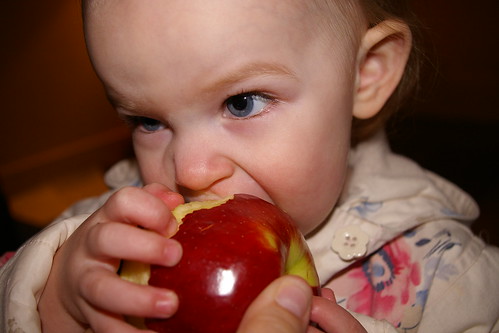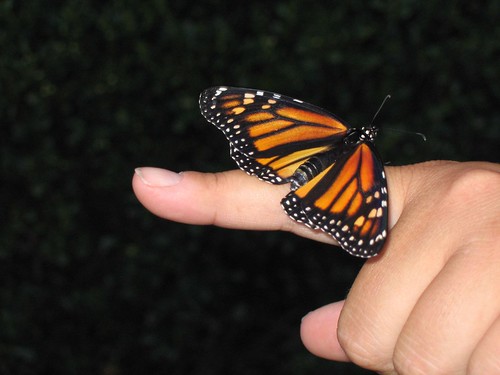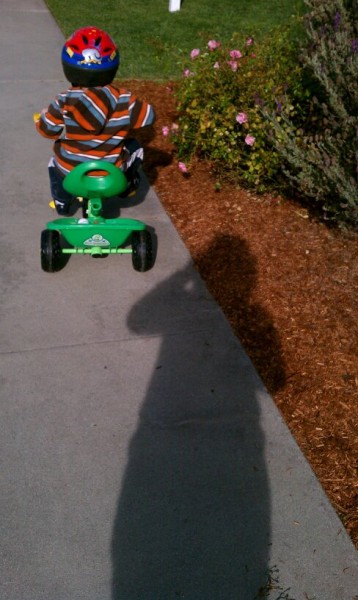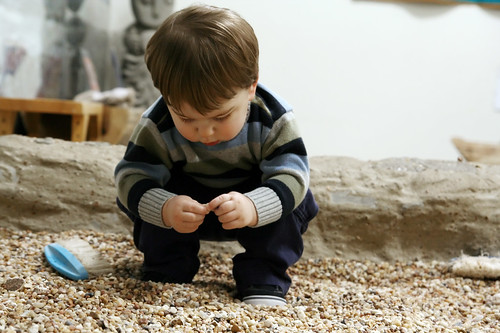Heather writes: My son is 15 months old and a biter. He has been biting me especially, but pretty much anyone or anything in his path for at least six months now. I have tried EVERYTHING. Like you, I am also in the Early Education field and have worked with kids and families for about ten years. I have worked with extremely challenging behaviors before and feel pretty qualified to handle most anything, but for some reason when it comes to my son and his biting I just can not find a resolution. Do you have any advice? Unfortunately, as the biting continues my response is becoming less and less ideal and I hate for this to be a defining moment of how I parent and how my son learns. I appreciate any advice and encouragement you can provide!
Hi Heather,
I know it may sound odd, but in this case, it may actually help you to try to step back a little, and to look at your son’s behavior through your “professional eyes”, instead of through your “Mom eyes”!
Many toddlers will bite at one time or another, but supporting a toddler who is biting on a regular basis can be a real challenge, and it can be especially hard to remain calm when the biting is directed at you, and/or it’s your own child who is doing the biting. It’s common for parents to feel they are doing something wrong, and/or that their child’s behavior reflects badly on them, especially since biting is a behavior that often arouses strong negative feelings (and sometimes even fear) in adults.
I want to encourage you to begin by taking a step back and re-framing your description of the problem. This may seem like a small thing, but it’s important to separate your child’s behavior from the whole of who your child is. As soon as we describe a child using a label, “He’s a biter,” ” She’s shy,” “He’s a bully,” “She’s a clown,” it can become difficult to see anything else about the child, and to separate the behavior you don’t like from the child that you love. So- your son is not “a biter” but a young toddler who bites, and your goal is to help him learn alternative ways to communicate. This is a much more neutral and powerful place to begin when trying to cope with a challenging behavior. “Biters” are often thought of as being “bad children,” “out of control,” “bullies,” or “antisocial”. Nothing could be further from the truth. A young toddler who is biting as a way of communicating needs support to understand and learn to communicate feelings in ways that don’t hurt others.
Let’s start by looking at the reasons toddlers might bite. Very often, biting occurs as a natural extension of a child’s learning and exploration. Young children explore their world using all of their senses, and will often mouth or bite toys as part of their play. In the course of exploring, they may experiment with mouthing or biting people as well as objects, because they are curious, or maybe they are teething. When they bite, they may find it feels good! and/or they may receive very strong reactions from those around them, which may make it more tempting for them to try the behavior again. In group situations, children sometimes copy each other’s behavior. Other children bite when they feel crowded, angry, frustrated, overwhelmed, over-excited, or out of control.
It’s common for pre-verbal toddlers to express themselves using actions as opposed to words- think of a toddler who takes a toy from another’s hand, or one who drops her food on the floor to indicate she’s done eating, or one who brings a blanket to a friend who is sad. Toddlers feel and understand so much, and have so much they want to express, and their ways of expressing themselves are often direct and action oriented.
Young children are in the very beginning stages of developing impulse control, social graces, and empathy, and are just learning to express desires, frustration, and pain through using words instead of through crying or taking action. Your son may know it hurts when someone bites him, but he can’t yet easily take the perspective of another, and he may not yet understand that it hurts you when he chomps on your arm. He will gain the ability to take another’s perspective through repeated experience, and with support and modeling from patient, loving adults.
Whatever the reason for the biting, you want to make it clear that biting another person is not a choice or an option. Although the curiosity or feelings that lead to the biting are acceptable, biting is not an acceptable way to express feelings.
1) The best way to stop biting is to prevent it from occurring, if at all possible. Be prepared. Observe closely, learn to anticipate the bite, and try to stop it before it happens. Block the bite if at all possible, by placing an arm between two children or an object (like a pillow) between your body and your child’s while saying, “I won’t let you bite.”
2) If a bite occurs: Calmly, but consistently and firmly, set limits. It can be tough to stay calm, especially if you are the one being bitten, because biting hurts, but it is so important, because big reactions are interesting to young children and if your son is getting a strong reaction from you (or anyone else), this may inadvertently encourage the biting behavior. Your son may be getting the message that biting is a way to make things happen. Regain your composure as quickly as possible, and say, “I don’t want you to bite. Biting hurts.” If the biting occurs when you are holding your child, you might put him down, or move him away from you saying, “I am going to move you away from me because you’re biting.” And then gently, and kindly, but firmly, move him away from you. If another child has been bitten, stay calm and offer comfort to the child who has been bitten, but avoid making too big of a deal of the incident, so it doesn’t become too interesting to either child. You might say, “X bit you and you are crying. Does it hurt? Let’s go wash your arm with some cool water to make it feel better.”
3) Offer an acceptable alternative to biting. It helps to have a teether or two handy to offer to a child who is biting.”If you need to bite, bite this.” (Some children benefit from wearing their own teething necklace or bracelet. Look here and here for products I’ve used and recommend.)
When biting behavior becomes a habit, or is persistent and chronic, it can be helpful to ask yourself, 1) “What need is being met for my child through this behavior?” and 2)”How can I help my child to get this need met in a way that doesn’t hurt others?”
It’s important to look closely at your home environment and your child’s daily schedule for clues to determine when biting is most likely to occur. Sometimes, a pattern can be discovered. Try to take note of what happens BEFORE the bite, so you can be prepared to intervene as calmly and casually as possible. Often, this means staying close and “shadowing” your child, especially in situations where you know biting is likely to occur.
Your child may be feeling out of control, or testing boundaries if biting has become habitual. Many young toddlers resort to biting when they are over stimulated, so try to be mindful of, and reduce environmental stress and sensory overload as much as possible. If you can discover the underlying triggers, and you consistently respond by calmly setting a limit and offering an alternative, your toddler will eventually learn to express himself without feeling the need to bite.
All young toddlers benefit from predictable daily routines, and it helps to be mindful of tiredness, hunger or low blood sugar, and over-stimulation. Some children benefit from a much reduced noise and activity level, and much more active play outdoors. Consider reducing or eliminating all screen time if you currently allow it. If bites tend to occur more in group situations, it may be helpful or necessary to take a break from group activities for a time, if at all possible. If your child attends childcare, it is important to confer with his caregivers to make sure everyone is responding consistently and in the same calm way when biting occurs. It can be helpful to talk openly with adult family members and friends (not in front of your son) about what is going on and how you are handling it, especially if you are engaging in social situations with them and their children.
Sometimes it helps to assign one adult to be a “buddy” or shadow a child in group situations. Having a trusted adult nearby to provide narration of events can be comforting and soothing to a toddler who feels overwhelmed with sensory input, or crowded by others. Get into the habit of naming emotions for your child (his, yours, and other people’s) and when he has the need to bite, give him healthy, safe alternatives. Encourage your son to bite on something safe, punch pillows, take a deep breath, stamp his feet, or yell “Stop” to get feelings of frustration or anger out. Time spent in nature often has a very soothing effect as do activities like water play, shaving cream art, and play dough.
Most of all, I want to encourage you to hang in there with your son, and have faith that he will move through this challenging phase with your guidance and support- because he will- and you have what it takes to help him! Notice and celebrate each and every time he shows self restraint, and doesn’t bite. If you consistently respond to your son’s biting behavior in the way I’ve outlined, you will see positive improvement in time (usually about four weeks). If you feel you’re already doing all you can do, or you are at your wits end, and nothing seems to be helping, then it might be worthwhile to consider a personal in-home consultation with a professional. Sometimes, it can be enourmously helpful to hear the viewpoint and perspective of an experienced person who is looking at your situation with unbiased eyes, and can offer insight and support as you make your way through a difficult patch.
I hope others who have been where you are might also offer their thoughts and support in the comments. Please let me know how things are going… I’ll be thinking of you!










